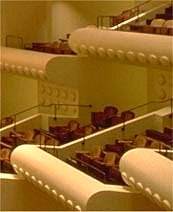 The
title of this concert, and the fact that it is part of a tour, suggest that
it might be simply the concert of the CD. Gidon Kremer's Cinema CD
is exhilarating and enjoyable, but there is far more to a live performance
by KREMERata Baltica, the superb string ensemble with the daft name. The
programme, which seems to be constantly evolving for this tour, homes in
precisely on the wonder of what happens when musicians and audience together
experience music. The notes in work may be fixed, as a film is, but every
projection is something new for the audience. Kremer and his players also
have a unique, intimate, grasp of how tonight's composers, mainly of the
late twentieth century and the former Soviet Union, exploit and explore the
theatre inherent in an orchestral performance, in humorous but serious ways.
The
title of this concert, and the fact that it is part of a tour, suggest that
it might be simply the concert of the CD. Gidon Kremer's Cinema CD
is exhilarating and enjoyable, but there is far more to a live performance
by KREMERata Baltica, the superb string ensemble with the daft name. The
programme, which seems to be constantly evolving for this tour, homes in
precisely on the wonder of what happens when musicians and audience together
experience music. The notes in work may be fixed, as a film is, but every
projection is something new for the audience. Kremer and his players also
have a unique, intimate, grasp of how tonight's composers, mainly of the
late twentieth century and the former Soviet Union, exploit and explore the
theatre inherent in an orchestral performance, in humorous but serious ways.
This was clear from the start, when the ensemble played themselves on with a segment by Nino Rota, basses and cellos first, then violins and violas playing as they entered. A viola player and a bass player then exited and the ensemble looked at each other, waiting. It wasn't clear if this was part of the game or not, but it created appropriate suspense before the first piece, Herrmann's Psycho narrative. Someone emerged with music for the basses during this, so it was probably a librarian's slip-up caused by the on-the-fly rearrangement of the programme. But it could have been a conspiracy, or an illicit affair, or something else quite Hitchcockian. This version of the Psycho music was a set of bitingly brief sections that encapsulate the whole film in a very few minutes, and was played without a conductor and with nerve-racking intensity.
 Takemitsu's
Nostalgia, music for Tarkovsky's film arranged as a suite in memory
of the director, was, surprisingly, the most conventional work on the programme,
a lush romantic meditation. Kancheli's Little Daneliada for Strings,
also an arrangement of film music, was wonderfully playful, a gleeful exploration
of different styles of performance music that had the players vocalizing
the reactions of an imaginary audience. The effect was like one of the early
Warner Brothers sound animations, a circus or theatre scene where the audience
is included inside the film to bridge the gap between the mechanical reproduction
of a performance and the live response to it. Schnittke's Moz-Art à
la Haydn was similarly both entertaining and enlightening in its awareness
of the importance of what happens on the platform. The string players, initially
in the dark, explore snippets of a theatrical score by Mozart of which only
the first violin part survives. The performance goes all over the place,
into full-strength quotations from Mozart but also into games about performance
itself, and ends as the players remove themselves from the platform à
la Haydn.
Takemitsu's
Nostalgia, music for Tarkovsky's film arranged as a suite in memory
of the director, was, surprisingly, the most conventional work on the programme,
a lush romantic meditation. Kancheli's Little Daneliada for Strings,
also an arrangement of film music, was wonderfully playful, a gleeful exploration
of different styles of performance music that had the players vocalizing
the reactions of an imaginary audience. The effect was like one of the early
Warner Brothers sound animations, a circus or theatre scene where the audience
is included inside the film to bridge the gap between the mechanical reproduction
of a performance and the live response to it. Schnittke's Moz-Art à
la Haydn was similarly both entertaining and enlightening in its awareness
of the importance of what happens on the platform. The string players, initially
in the dark, explore snippets of a theatrical score by Mozart of which only
the first violin part survives. The performance goes all over the place,
into full-strength quotations from Mozart but also into games about performance
itself, and ends as the players remove themselves from the platform à
la Haydn.
Piazzolla is close to being this ensemble's signature composer. They played
a selection, which included two pieces from the film Enrico IV, stunningly
as ever. The final piece, an arrangement of Dunayevsky's Circus fantasy
was an entertaining oddity, and also a delight. Dunayevsky has a reputation
as the Russian Gershwin, justified by his lightness of touch with blues style
romanticism, and only somewhat undermined by the fact that he wrote for the
Soviet film industry. After a couple of mainstream (by tonight's standards)
encores, the ensemble played themselves off again to Nino Rota, a bemused
viola playing bringing up the rear and leaving an ecstatic audience cheering.
H.E. Elsom
 Return to:
Return to: